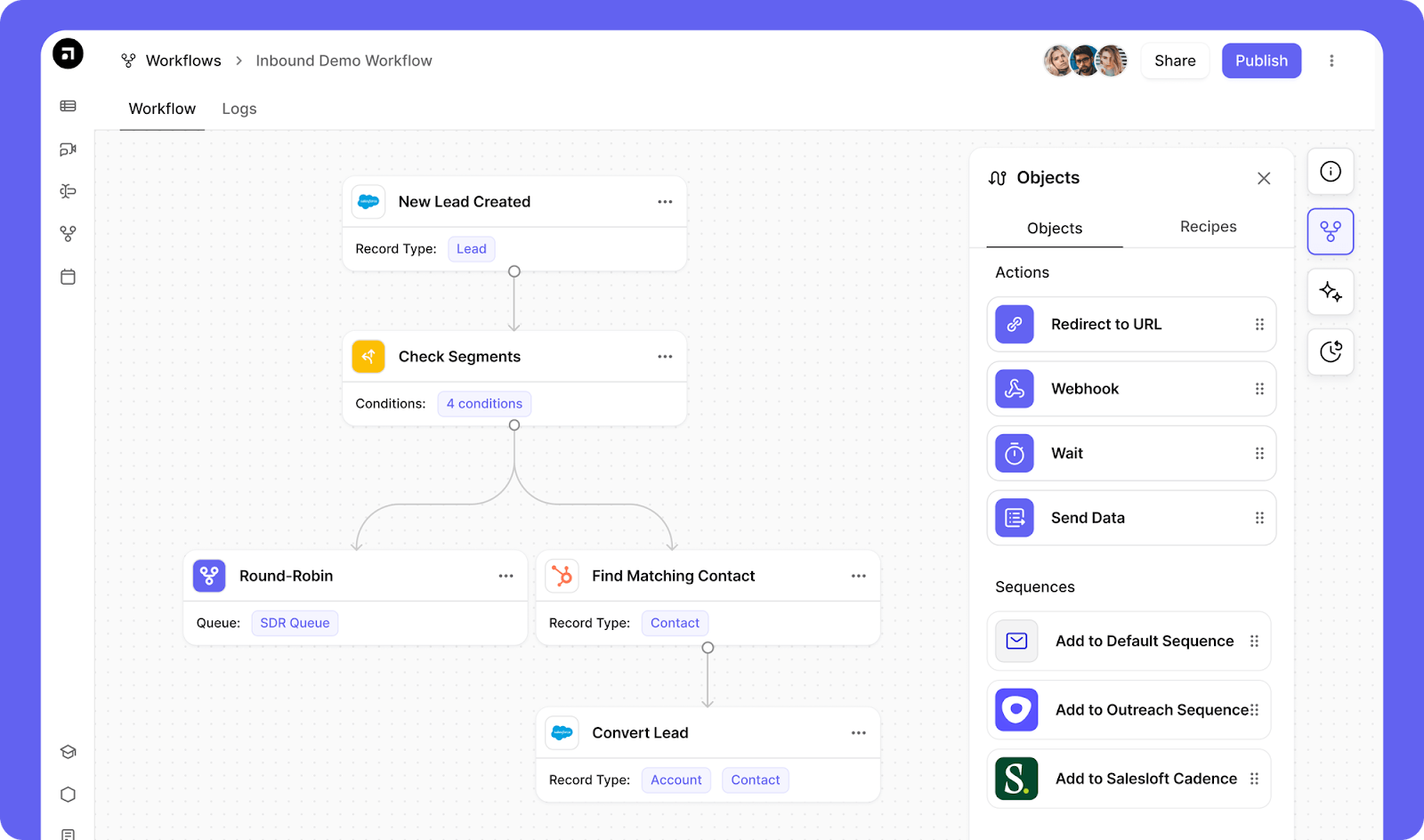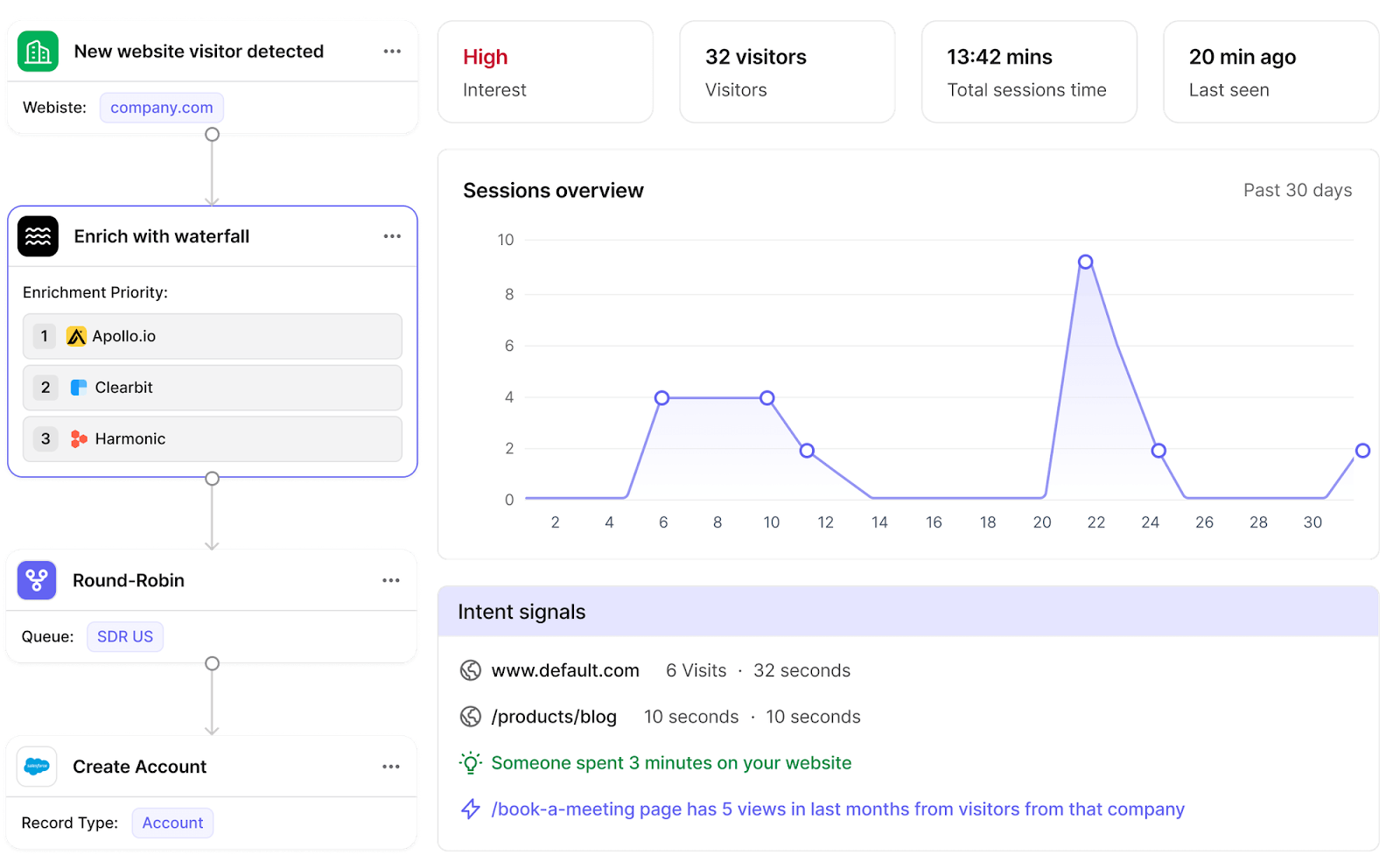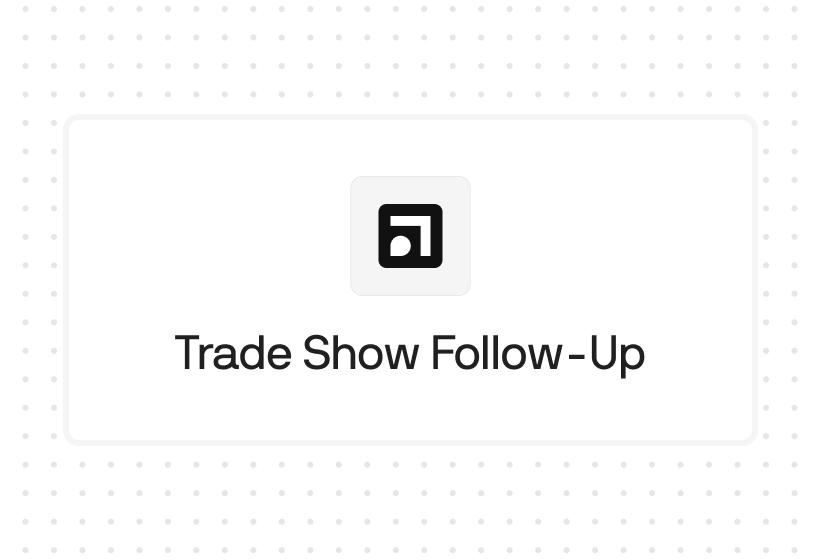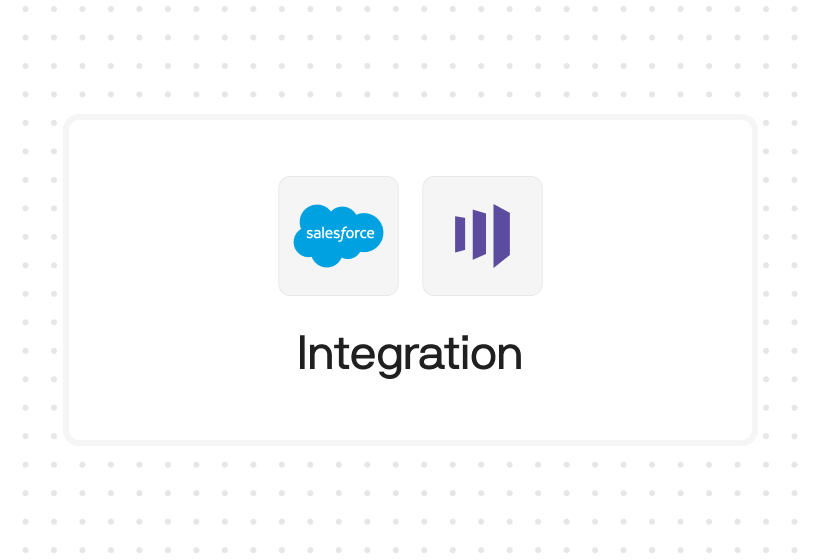Try Default

See how revenue teams automate revenue operations with Default.

Key Takeaways
- Focus on lead quality over volume: Target ICP-fit prospects showing clear intent to boost conversion rates and revenue impact, not just MQL counts.
- Combine inbound, outbound, and automation: Orchestrate owned content, targeted outreach, and real-time routing to engage buyers across their journey.
- Automate qualification and routing: Use enrichment, scoring, and CRM sync to get the right leads to the right reps instantly.
- Measure by pipeline impact, not activity: Track SQL conversion rates, channel ROI, and speed-to-first-touch—not just lead totals.
If your pipeline isn’t scaling, the problem likely isn’t demand—it’s motion. On average, just 13% of MQLs convert to SQLs, meaning 87% of your funnel is waste. That’s hundreds of lost opportunities, wasted SDR bandwidth, and inflated forecasts that never materialize into deals.
In 2025, lead generation isn’t about stuffing the funnel—it’s about capturing intent signals, qualifying instantly, and routing with surgical precision. The teams that win are the ones who automate the process—turning anonymous clicks into SQLs and making every rep dramatically more productive.
This guide breaks down 18 proven strategies you can put into play right now—each designed to cut wasted motion, improve lead quality, and generate pipeline that actually converts.
What is B2B lead generation?
B2B lead generation is the process of identifying and engaging business decision-makers who match your ideal customer profile (ICP) and show buying intent. It’s not about collecting email addresses—it’s about creating qualified opportunities that can move quickly into pipeline.
Unlike B2C, where buyers often make quick, individual decisions, B2B sales cycles are longer, more complex, and involve multiple stakeholders. That makes accurate data, precise segmentation, and well-timed engagement critical.
The real goal isn’t volume—it’s building a repeatable, scalable system that converts the right prospects into revenue instead of filling your funnel with unqualified contacts.
The two types of B2B leads
Not all leads are equal. Treating them as if they are slows down sales, clogs the funnel, and wastes SDR time. B2B leads fall into two categories:
Sales qualified leads (SQLs)
Prospects who meet firmographic and behavioral criteria and have demonstrated clear buying intent, such as visiting a pricing page, requesting a demo, or hitting a lead score threshold. SQLs should be routed to sales immediately with full context, as they typically convert faster and at higher ACV.
Marketing qualified leads (MQLs)
Prospects who have engaged with your marketing (e.g., downloaded a guide, attended a webinar) but lack strong intent signals. These leads need scoring, segmentation, and nurturing before sales engagement. Loose MQL definitions lead to wasted sales effort and weaker marketing credibility.
Clear MQL and SQL definitions are the foundation for effective SLAs, intent-based nurture flows, and sales–marketing alignment that drives real pipeline growth.
18 effective strategies to generate B2B sales leads
The strategies below combine inbound, outbound, and automation plays designed for RevOps and GTM leaders who want pipeline that scales.
Each one is practical, automation-ready, and tied to real revenue impact—not vanity metrics.
1. Automate lead capture and routing with smart forms
Static forms slow down lead flow and force manual triage. Replace them with dynamic, logic-based forms that adapt in real time to each buyer’s profile—capturing the right data, triggering enrichment, and routing leads instantly based on territory, fit, and intent.
Why it works
Instant qualification and routing cut response times, eliminate manual sorting, and ensure reps focus only on sales-ready, ICP-fit leads. Faster speed-to-lead directly increases conversion rates and pipeline velocity.
Default integrates seamlessly with your web forms or powers your capture using its own no-code Default Forms, and automates routing through customizable, AI-powered workflows—no engineering required.

2. Use enrichment tools to qualify leads instantly
Every minute spent manually researching a lead delays follow-up and risks losing the deal. Real-time enrichment fills in missing firmographics—such as job title, company size, funding stage, and tech stack—the moment a lead is captured, enabling instant scoring and routing.
Why it works
Accurate, complete profiles at the point of capture eliminate guesswork, prevent misrouting, and get qualified leads to sales faster—directly improving conversion rates.
Default performs real-time waterfall enrichment, layering multiple providers to maximize match rates and automatically fill gaps in lead data.

3. Prioritize high-intent accounts with website visitor tracking
Some of your best prospects will research your solution without ever filling out a form. Website visitor tracking reveals which ICP-fit accounts are active on your site—so you can engage them before competitors do.
Why it works
Early engagement with in-market accounts gives your team a decisive advantage, allowing outreach to start while interest is highest and before they enter other vendors’ pipelines.
Default detects high-intent sessions from ICP-fit accounts and sends real-time alerts to reps—transforming anonymous visits into actionable sales opportunities.

4. Offer gated content with high perceived value
Generic lead magnets pull in unqualified traffic. Instead, create interactive, decision-enabling assets—such as ROI calculators, benchmark reports, or buyer’s guides—that attract engaged, mid-funnel prospects.
Why it works
These assets naturally filter for higher-fit leads and capture richer data points for segmentation and follow-up. Dynamic forms that adapt questions based on content type or funnel stage can further improve conversion rates and data quality.
5. Run hyper-personalized outbound campaigns
Generic outbound gets ignored. Use segmentation and enrichment data to craft messaging that speaks directly to each prospect’s role, industry, maturity, and pain points.
Why it works
Relevance increases reply rates, speeds up qualification, and improves conversion—especially when outreach is timed to intent signals like website visits or product usage. Layering these triggers into outbound workflows ensures your message lands when prospects are most likely to engage.
6. Retarget warm leads with personalized ads
Most visitors won’t convert on their first visit, but their behavior still signals interest. Retarget high-value leads with segmented ad campaigns tailored to their actions—such as viewing pricing, signing up for a webinar, or returning multiple times.
Why it works
Personalized retargeting keeps your brand in front of engaged prospects, nudges them toward conversion, and turns non-handraisers into qualified leads at a fraction of the cost of net-new acquisition. Matching ad creative to their journey stage—like BOFU offers for demo viewers and educational content for blog readers—drives stronger results.
7. Deploy chatbots for real-time qualification
Buyers expect instant responses, but sales teams can’t be online 24/7. Smart chatbots engage visitors the moment they land on your site, ask targeted qualification questions, and book meetings automatically based on routing rules.
Why it works
Chatbots remove delays, convert high-intent visitors directly from key pages like pricing or demo, and keep pipeline flowing even outside business hours. Programming your bot to collect firmographic and discovery details aligned to SQL criteria ensures reps only spend time on qualified leads.
8. Host industry-specific webinars and roundtables
Generic webinars draw broad audiences with low conversion potential. Instead, design sessions tailored to a specific vertical, role, and pain point—such as “Pipeline velocity tactics for RevOps leaders at SaaS companies.”
Why it works
Targeted topics attract higher-fit attendees, build domain authority, and create a natural path for post-event qualification. Using live polls or Q&A to gather insights like team size, tech stack, and priorities gives sales immediate context for follow-up and lead scoring.
9. Build partner co-marketing campaigns
Collaborating with complementary platforms or service providers lets you reach warm, adjacent audiences without starting from scratch. Joint webinars, playbooks, or bundled content can generate net-new leads while splitting the cost and workload.
Why it works
Partnerships bring in high-fit prospects warmed by third-party credibility, reducing the need for cold outreach. Tagging and tracking partner-sourced leads in your CRM makes it easy to measure influence on pipeline and optimize future campaigns.
10. Segment your lead nurturing by intent stage
Treating every lead the same slows down sales and bloats the funnel. Segment by behavioral and firmographic signals—such as visiting a demo page versus downloading a top-of-funnel guide—and tailor nurture sequences accordingly.
Why it works
Stage-specific messaging preserves SDR bandwidth, routes only sales-ready leads for follow-up, and increases conversion by delivering the right content at the right time. Dynamic email content blocks and lifecycle stages in platforms like HubSpot or Marketo make it possible to personalize nurture tracks at scale.
11. Use calendar links to reduce scheduling friction
Back-and-forth scheduling costs momentum when intent is at its peak. Embedding rep-aligned calendar links in outbound emails, chatbot flows, and thank-you pages lets prospects book instantly from high-intent pages like pricing or demo requests.
Why it works
Removing scheduling delays accelerates speed-to-meeting and keeps deals moving while interest is high.
Default’s scheduling engine routes leads directly into the right rep’s calendar, automatically aligning booking flows with territories and meeting types—removing manual routing from the process.

12. Launch ABM campaigns targeting high-value accounts
Account-based marketing (ABM) focuses your resources on the accounts most likely to deliver meaningful revenue. Use firmographic, technographic, and intent data to identify high-value targets, then engage key stakeholders through coordinated ads, outbound, and tailored content.
Why it works
ABM compresses sales cycles by delivering highly relevant, deal-stage content to the right people at the right companies. Aligning ABM engagement signals with routing rules ensures SDRs follow up as soon as interest peaks.
13. Refresh and relaunch top-performing content
You don’t always need new assets to drive results—often, your best-performing content just needs a refresh. Repurpose proven blogs, reports, or guides into new formats like webinars, checklists, or LinkedIn carousels, then relaunch them on a regular schedule.
Why it works
Refreshing high-performing content reduces campaign lift while maximizing ROI from assets you already know convert. Tagging leads by content version or channel lets you compare conversion performance over time and double down on the formats that deliver the best results.
14. Capture mid-funnel leads with interactive tools
Not every prospect is ready for a demo, but many are willing to engage with interactive, self-guided tools. ROI calculators, self-assessments, and diagnostic quizzes provide value while revealing key details about a prospect’s needs and priorities.
Why it works
Interactive tools create a two-way exchange—buyers get insights, and you gather qualification data that can feed directly into lead scoring. Prioritizing follow-up based on responses, such as urgency, budget, or pain points, ensures sales focus on the most promising opportunities.
15. Build lead magnets around industry benchmarks
Benchmark reports give prospects a way to measure themselves against their peers, making them some of the highest-converting gated assets in B2B. Whether produced in-house or co-branded with a partner, they offer immediate value without feeling like a sales play.
Why it works
Prospects perceive benchmarks as insight-first content, which drives higher engagement and better data quality. The results can also fuel outbound campaigns and landing pages with positioning like “See how your metrics compare to industry leaders,” creating a natural bridge to deeper conversations.
16. Add contextual CTAs to every key webpage
Generic CTAs miss the mark because they don’t match the visitor’s intent. Tailor calls-to-action by persona, funnel stage, and page type—such as “See how we help B2B RevOps teams” on pricing pages or “Explore our benchmarks” on blog posts.
Why it works
Matching CTA messaging to a visitor’s context drives more clicks and higher conversion rates without increasing traffic. Running A/B tests across product pages, using dynamic text based on referral source or campaign ID, and tracking performance by asset type helps refine results over time.
17. Use event follow-ups to re-engage high-fit leads
Many event leads lose momentum because follow-up is delayed or too generic. Build automated workflows that trigger within 24 hours of the event, using attendee data—such as session attendance, questions asked, or content downloaded—to guide tailored outreach.
Why it works
Fast, personalized follow-up keeps intent high and gives sales a relevant conversation starter. Tagging attendees in your CRM and aligning behaviors to SDR sequences or nurture flows ensures no high-fit lead slips through the cracks.
18. Sync lead data across your GTM stack in real time
Disconnected systems slow down follow-up, create data gaps, and make reporting unreliable. Integrating your CRM, marketing automation platform, enrichment tools, and sales engagement system ensures lead data flows instantly and accurately across your stack.
Why it works
Real-time data sync eliminates manual transfer delays, prevents lead leakage, and enables reps to engage prospects at the right moment with complete context.
Default acts as your orchestration layer—syncing data, deduplicating records, and triggering workflows across Salesforce, HubSpot, Outreach, and more.
The proven process behind scalable B2B lead generation
A strong lead generation engine isn’t built from isolated tactics—it’s powered by systems that operationalize speed, precision, and scalability at every stage. High-performing RevOps and GTM teams follow this sequence:
1. Data enrichment at the point of capture
Enrich leads in real time to auto-fill critical firmographics like job title, company size, and tech stack the moment they’re created. This enables immediate scoring and routing.
Impact: Eliminates delays between lead capture and rep action, improving fit filtering and speed-to-lead.
Default enriches leads in real time using waterfall logic across multiple providers—maximizing match rates and ensuring every record is complete from the moment it’s captured.

2. Lead segmentation for smarter workflows
Group leads by firmographics, funnel stage, source, and behavioral signals. Segmenting by intent tiers—like demo viewers vs. blog readers—makes targeting and prioritization easier.
Impact: Increases engagement relevance and improves nurture-to-SQL conversion.
3. Lead scoring and prioritization
Combine fit signals (ICP match, company size) with behavioral intent (e.g., pricing page visits, demo requests) to identify sales-ready prospects.
Impact: Ensures reps focus on qualified leads, reducing wasted effort on low-fit contacts.
4. Lead routing and assignment
Use defined logic or AI rules to assign leads based on territory, product line, buying stage, or account status. Push leads directly into calendars, inboxes, and CRM records.
Impact: Prevents lead loss, accelerates follow-up, and improves SLA compliance.
Default routes leads instantly using natural-language rules—eliminating spreadsheets, manual handoffs, and custom code.

5. Personalization at scale
Tailor outreach to each lead’s profile and activity using dynamic fields, persona-specific nurture tracks, and behavioral triggers.
Impact: Increases reply rates, meeting bookings, and outbound conversion velocity.
6. Continuous CRM hygiene
Deduplicate records, normalize fields, and flag missing enrichment or routing metadata to keep data clean and actionable.
Impact: Improves reporting accuracy and ensures smooth SDR-to-AE handoffs.
Default automatically deduplicates records, fills missing metadata, and flags anomalies in real time—keeping your CRM accurate, reliable, and ready for revenue reporting.
The execution roadblocks slowing your campaigns (and how to fix them)
Strong strategy and quality data mean nothing if execution breaks down. Most B2B campaigns fail not because of demand, but because of misalignment, poor lead quality, and broken systems. Here are four common roadblocks—and the fixes high-performing teams use to keep pipeline moving.
Challenge: Misalignment between marketing and sales
Marketing hands off leads with minimal context, sales ignores MQLs due to poor fit or timing, and both teams lose trust.
Strategic fix:
- Define MQL and SQL thresholds using both behavioral and firmographic scoring.
- Automate lead handoff with attribution, funnel stage, and last-touch details.
- Use shared dashboards to track post-handoff progress, not just form fills.
Impact: Fewer missed opportunities, faster follow-up, and clearer ROI attribution.
Challenge: Poor lead quality from paid channels
Paid campaigns often deliver volume at the expense of fit; burning both budget and SDR time.
Strategic fix:
- Enrich leads at the point of capture.
- Apply firmographic filters directly in ad platforms.
- Route only ICP-fit leads to sales; send others to nurture.
Impact: Paid spend is optimized for SQL creation, not just top-of-funnel clicks.
Challenge: Low conversion from content offers
Content draws traffic, but without the right triggers, it produces disengaged leads who never progress.
Strategic fix:
- Add intent-triggered CTAs and exit popups.
- Personalize landing pages by referral source, persona, or funnel stage.
- Use post-download workflows to prioritize follow-up by asset type and engagement level.
Impact: Higher mid-funnel movement and stronger lead-to-opportunity lift.
Challenge: Data silos and tech stack fragmentation
When lead capture, enrichment, routing, and CRM sync live in separate tools, data flow is slow and error-prone.
Strategic fix:
- Centralize orchestration across the funnel with an automation layer.
- Build workflows that score, route, enrich, and sync in real time.
- Standardize field-level data across all systems.
Impact: Eliminates lead loss, accelerates speed-to-lead, and enables scalable RevOps processes.
Default automates enrichment, routing, and data sync across your GTM stack—removing friction and keeping data consistent everywhere.

The KPIs that actually matter in B2B lead generation
Lead volume is a vanity metric. What actually separates top-performing teams is how efficiently they turn leads into pipeline. Conversion rates, speed-to-first-touch, and revenue per source tell the real story—everything else just hides wasted motion.
Key KPIs to track:
- Lead-to-opportunity conversion rate – Shows how effectively leads progress to qualified pipeline, highlighting gaps in lead qualification, follow-up, or offer alignment.
- Cost per SQL (or per opportunity) – Goes beyond CPL to measure the true cost of creating qualified pipeline, enabling smarter budget allocation.
- Pipeline contribution by source/channel – Identifies which channels and campaigns generate revenue-driving conversations, not just form fills.
- Time-to-first-touch (TTFT) – Measures how quickly reps engage new leads; faster engagement correlates with higher win rates.
- Revenue per lead source – Ties each source to closed-won deals, revealing the most profitable acquisition channels.
Combine attribution data with engagement signals and lead scoring velocity to pinpoint not just where leads originate, but which channels actually accelerate pipeline and revenue.
Turn strategy into execution with Default
Manual handoffs, delayed routing, and scattered tools don’t just slow your funnel—they cost you pipeline. High-growth GTM teams are moving to a single control layer that automates enrichment, routing, and sync—so every lead is worked instantly, accurately, and at scale.
Default gives you that layer. It delivers:
- Real-time enrichment and scoring at the point of capture
- Instant lead routing and rep assignment based on ICP fit and territory
- Alerts on high-intent website activity—even without a form fill
- Clean CRM sync with deduplication and attribution built in
- Automated scheduling flows that remove booking friction
Every rep hour spent chasing the wrong lead is pipeline lost—the real question isn’t whether you need more leads, it’s whether your systems can turn the right ones into revenue before competitors do.
Book your interactive demo and see how Default powers a pipeline built for precision.
Conclusion

Former pro Olympic athlete turned growth marketer! Previously worked at Chili Piper and co-founded my own company before joining Default two years ago.
Accelerate your growth with Default.
Revamp inbound with easier routing, actionable intent, and faster scheduling















.png)








%201.svg)



.svg)





%201.svg)



%201.svg)

